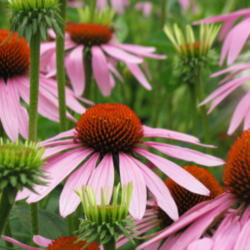Easy to grow, beautiful to look at, preferred by butterflies, and good for the body. Every garden should include Echinaceas!
This article was originally posted on August 6, 2014. It was a good gardening idea and worth seeing again, so we hope you enjoy revisiting it.
Coneflowers are some of the most carefree plants you can have in your garden. Of the
13 different species and nearly 200 different cultivars, with sizes ranging from 12 inches to 4 feet and coming in nearly every color you could want, there is an Echinacea available for every garden.
Purple Coneflower (Echinacea purpurea) is the easiest of them all and will establish itself the quickest, tolerate heat the best, and naturalize the easiest. Even so, the other species are just as robust! Once established, they will tolerate drought and require very little care. Deadheading is beneficial to encourage repeated blooming, weeding will keep your coneflowers from competing for resources, and well-drained soil will ensure that your plants won't rot. They prefer full sun, but will tolerate some light shade if you don't mind fewer flowers. They bloom nearly all season long, so they are also my "go-to" for cut flowers -- lasting indoors almost a week, even with neglect!
The common name for Echinacea is coneflower because the seed head rises above the petals and forms a cone shape.
You can see the shape clearly in most of the species, but the feature is missing in many of the hybrids.
Echinacea is probably the most well-known medicinal herb grown. It traditionally has been used to boost the immune system and fight infections. This statement has not been evaluated by the FDA.

The entire plant can be used: root, leaves, flower, and seed. The most widely used are the root and leaves, either dried or fresh. Leaves or roots are used fresh or dry, either steeped in tea to be consumed immediately or made into a tincture for later use.
Narrow-leaf Coneflower (Echinacea angustifolia) is the preferred species to use medicinally due to the fact that
Purple Coneflower (Echinacea purpurea) appears to lose its effectiveness when dried.
Like most other perennials whose roots are used herbally, Echinacea takes 3 years to fully absorb the alkaloids from the soil, and it should not be harvested until then. If you wish to use it prior to the 3 years, the other parts can be used, but they will not be nearly as potent.
